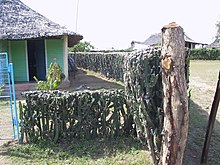Cactus fence
This article needs additional citations for verification. (November 2009) |



A cactus fence is a hedge or fence made of closely spaced cactus plants, sometimes with barbed wire or wood interwoven with the cacti.
Purpose
[edit]Such fences are inexpensive to develop in regions where cacti are common, and can provide an extreme deterrent to any but a determined human intruder. Often their primary function is to keep wandering large animals off a private property.
Design
[edit]Sometimes, cacti are used as barriers without being formed into a structured fence. Prickly pears (mostly Opuntia stricta) were imported into Australia in the 19th century for use as a natural agricultural fence and to establish a cochineal dye industry, but quickly became a widespread weed.
Closely spaced columnar cacti such as Trichocereus or Mexican fencepost cactus can be used for more structured, space-saving fences.[1][2]
In the American southwest, ocotillo stems are often set in the ground to form a structure similar to a cactus fence.
References
[edit]- ^ Falkenthal, Gayle Lynn (2017-09-14). "Living Walls and Fences Are A Natural Choice". Good Earth Plants. Retrieved 2025-01-31.
- ^ Gilmer, Maureen. "Turn extra cactus into a living fence". The Desert Sun. Retrieved 2025-02-01.
- The cactus family, 2001, Edward F. Anderson, pp. 68–9.
